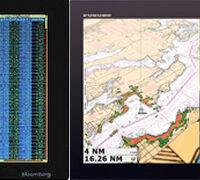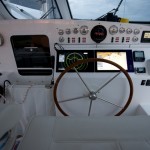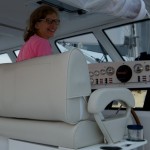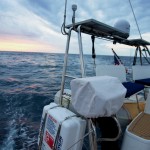A while ago, early in the morning, I (Gail) was on my first solo watch. I began thinking about some of my friends back home and started writing an email to tell them what I was doing. Usually, these emails in my head are one-way conversations. This time I wrote it down.
When on a passage for multiple days, someone needs to be on watch at all times. This is like today’s world of 24-hour markets where someone always needs to be holding the trading book. But how do you know where to go, or what to look out for? At the start of a passage, the Navigator (or in market lingo, the Chief Investment Officer) will set a series of waypoints. The Navigator does this based on experience with the area, weather predictions, and knowledge of the boat. This is like your Strategic Asset Allocation. But how do you track your performance? The boat has a compass and GPS, just like the pricing functions needed for Asset Allocation; GPS is your instantaneous pricing and the compass needle is your allocation.
Suppose you have a few asset classes and are trading (or using your rudders to steer) to maintain that allocation using an automated trading system (usual conditions such as continuous pricing, liquid assets and homoskedasticity apply). On the boat, the autopilot serves this function. It is programmed to either follow a course (allocation) by steering the boat at a steady angle to the wind, according to a compass direction or heading towards a waypoint. Strategically and tactically, you can not just stay on autopilot and walk away. You need your Network (Eyes and Ears), Bloomberg Terminal(Chartplotter/Radar), Financial Times(Weather Reports), and S&P 500(GPS).
- Two Fish ready for nighttime
- Gail’s Trading desk set up
- Gail adjusting asset allocation
- View much better than a trading floor
- Tracking Brazilian fishing boats
Like market news, the weather report’s value depreciates over time; it is something you would like to get often. We can fetch weather reports by downloading electronic GRIB (gridded information in binary form) files while offshore. The fastest way is when we have a working cell modem but this only works within a few miles of the shore, near towns. Cell modems are like having your servers right next to the exchange using fiber optics. In Brazil, it also requires a Brazilian SIM card, which is like having a local banking license since it requires a Tax ID. The next best way is to use our KVH satellite phone, which is like DSL. The slowest method is to use our Iridium satellite phone; this is like a 2400 baud Hayes Modem – painful but it can come through when needed. What if I don’t know how to interpret this weather info? I can look to my Market Strategist, aka a Weather Router, who looks at all of the data and gives me an interpretation of where and when I should sail that is specific to my situation.
We also have a Radar and AIS, which appear on our chartplotter, and like your Bloomberg terminal tells us current news of interest. Radar sends out radio waves that reflect back from other objects, such as ships, buoys and land. I just looked at my Radar screen. A new entrant in the market? Will she be a problem? Is she following the same Asset Allocation as I am? Will that crowd the market? Maybe I should change course or delay action so as not to be affected by her. I slowly steer the boat a bit to the right.
AIS (Automatic Identification System) is another thing we watch. We broadcast our ID via AIS so that other vessels can see us. We also have a radar reflector to make it easier for other boats to see us.
Just like anything else, using your brain and taking your head out of the boat/screens is the best way to confirm what is going on. Sometimes you also need to pick up the phone. We can use our VHF radio to do this. Fortunately, in the ocean, as opposed to financial markets, your counterparties are best served by full transparency and if you hail them, they will tell you exactly what they are doing. I am not sure how the existence of Sunspots will affect this equilibrium state.
Now I am watching the other boat follow its path away from me. I readjust my Tactical Asset Allocation back to the Strategic Course and we are back on our way.
Next week’s lesson: Volatility Trading, or, Using Sails.






6 Responses to Keeping Watch, or, Is Someone Moving my Market?